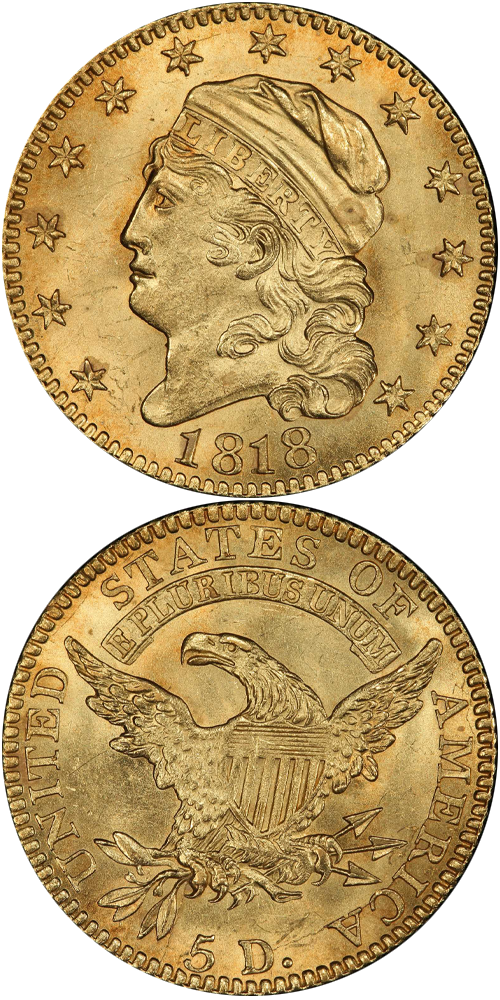1818 Capped Head Left Half Eagle
Normal Dies
Beginning in 1807, the year John Reich was hired, many obverse dies were made with an unusual punch used for the 13th star, one that shows a scallop or notch missing from one of its points. Many modern writers have attributed the peculiar 13th star to John Reich, calling it his “signature” or “secret mark,” pointing out that it did not appear until Reich’s permanent hiring. Reich left the Mint in April 1817, before 1818-dated dies were created, so the punch lasted longer at the Mint than he did. An obverse die made for 1820 dimes similarly uses the scalloped star punch for each of the 13 stars. Aside from these, and the 1818/7 half dollar, the scalloped star punch does not appear after 1815. The only 1817 half dollar die to use the scalloped star punch is the obverse of the 1817/4, which was left over from 1814.
No half cent, cent, dime, or quarter made during Reich’s term of employment uses this unusual punch. If the Reich signature theory was true, it would mean that the assistant engraver produced only dies for half dollars and gold coins, while Robert Scot, his boss, accomplished all subsidiary denominations. The uniting factor of the dies upon which the scalloped star appears, putting aside authorship for a moment, is value: it appears exclusively and uniformly on high denomination coins from 1807 to 1815. The peculiar punch appears on the only quarter eagle obverse die made during his tenure, dated 1808, as well as every half eagle obverse from the introduction of the Capped Bust in 1807 to 1815. It was apparently used on every half dollar obverse during the same period. If high value is the most closely correlated factor, more than Reich’s presence or absence, it may be at the heart of the explanation. Could the scalloped star punch have been an anti-counterfeiting tactic rather than an artist’s secret signature?
Clearly, any explanation of the scalloped 13th star will have to assume that the 1820 dime and 1818 half eagle obverses, which use the scalloped star punch for all 13 stars, are outliers, even mistakes. The 1818/7 half dollar, which uses the punch in the usual 13th position, may have another explanation, namely, that the die was made earlier than 1817.
The 1818 is a scarce date in the elusive and extremely challenging Capped Head Left half eagle series of 1813 to 1834. Most 1818 half eagles are of the BD-2 STATESOF variety. The other two die marriages of the date are appreciably scarcer, both ranked as Rarity-5. Of the BD-1 variety, only 50 to 60 coins are believed extant in all grades.
The example to the left was sold by Stack's Bowers Galleries in the D. Brent Pogue Part III Auction, where it realized $129,250.






